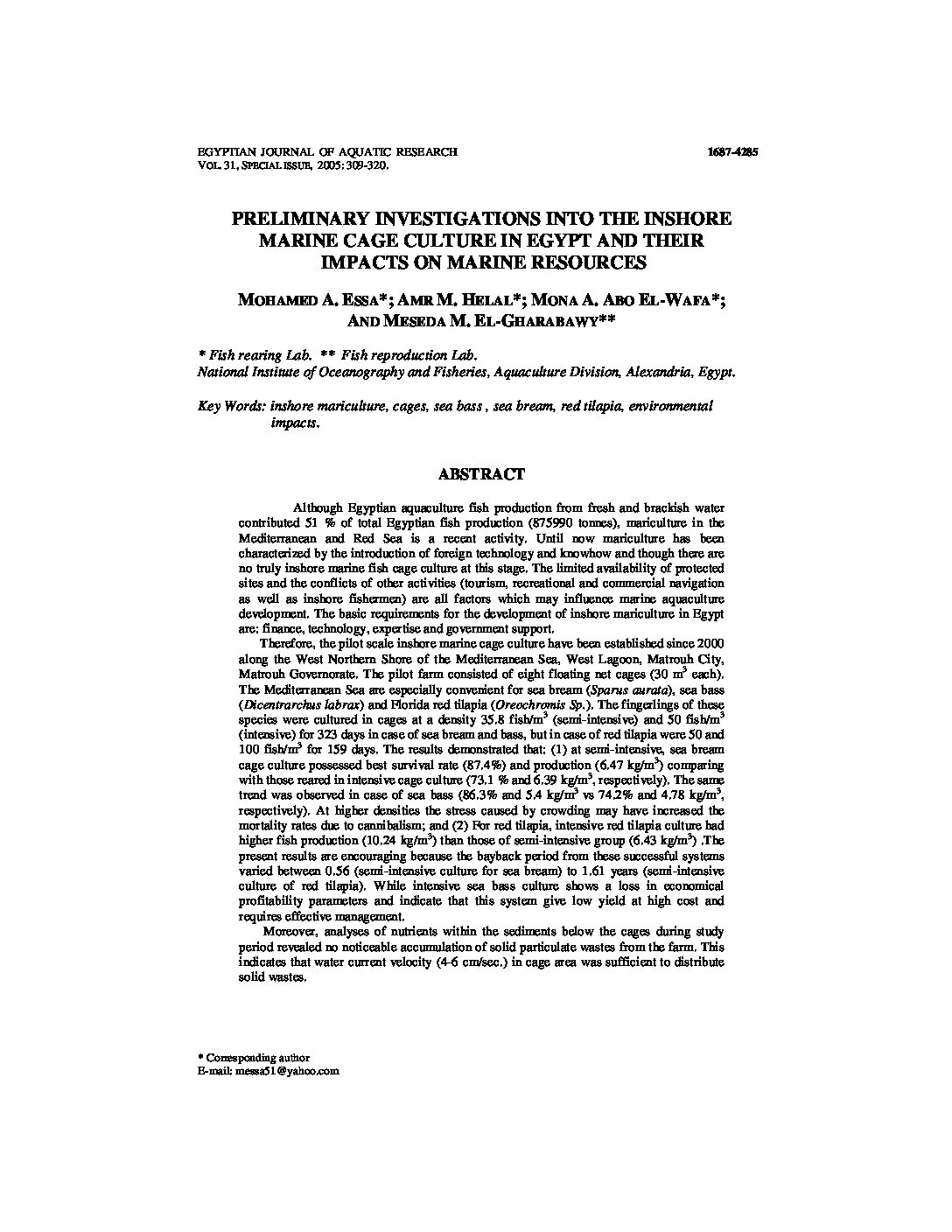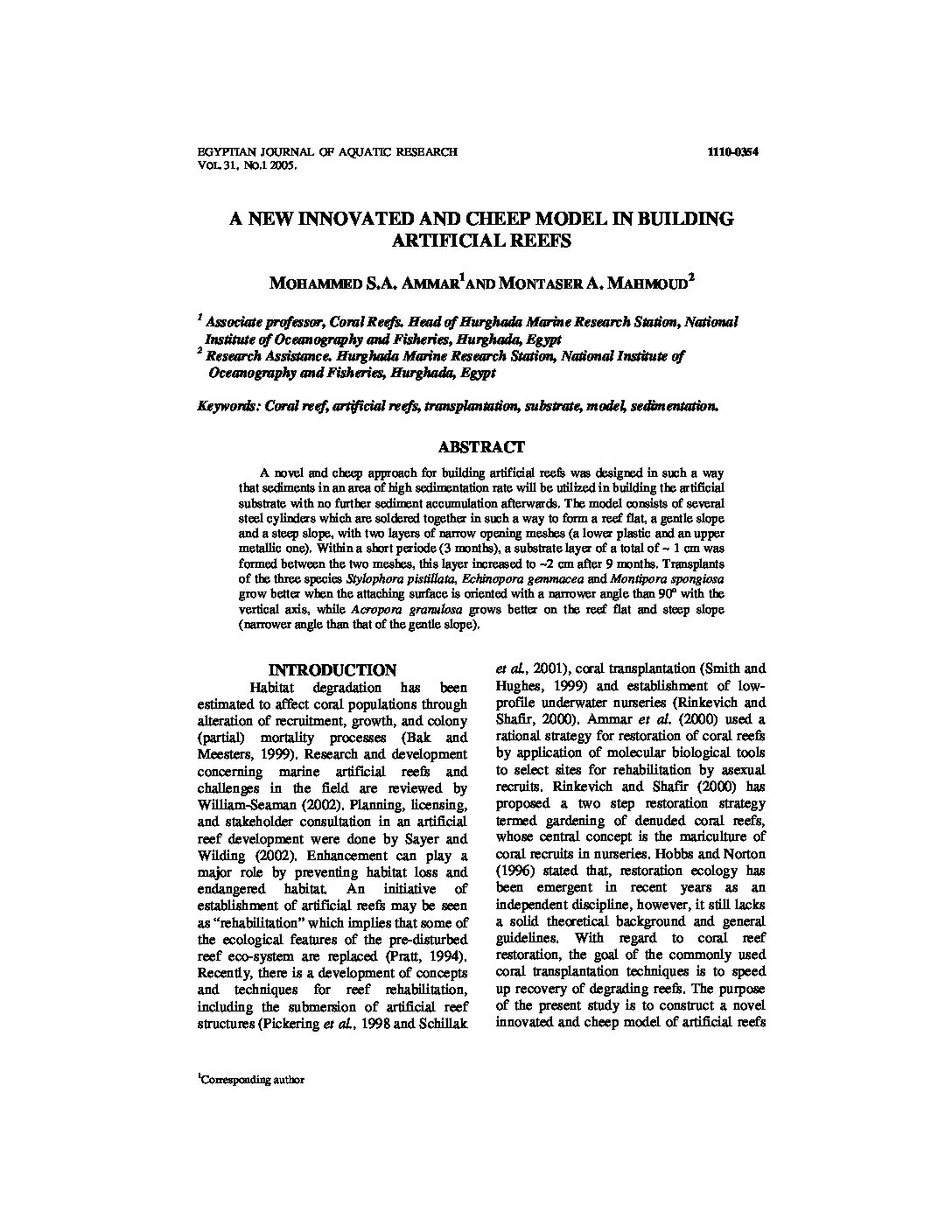Categories
vol-31PRELIMINARY INVESTIGATIONS INTO THE INSHORE
MARINE CAGE CULTURE IN EGYPT AND THEIR
IMPACTS ON MARINE RESOURCES
MOHAMED A. ESSA*; AMR M. HELAL*; MONA A. ABO EL-WAFA*;
AND MESEDA M. EL-GHARABAWY**
* Fish rearing Lab. ** Fish reproduction Lab.
National Institute of Oceanography and Fisheries, Aquaculture Division, Alexandria, Egypt.
Key Words: inshore mariculture, cages, sea bass , sea bream, red tilapia, environmental
impacts.
ABSTRACT
Although Egyptian aquaculture fish production from fresh and brackish water
contributed 51 % of total Egyptian fish production (875990 tonnes), mariculture in the
Mediterranean and Red Sea is a recent activity. Until now mariculture has been
characterized by the introduction of foreign technology and knowhow and though there are
no truly inshore marine fish cage culture at this stage. The limited availability of protected
sites and the conflicts of other activities (tourism, recreational and commercial navigation
as well as inshore fishermen) are all factors which may influence marine aquaculture
development. The basic requirements for the development of inshore mariculture in Egypt
are: finance, technology, expertise and government support.
Therefore, the pilot scale inshore marine cage culture have been established since 2000
along the West Northern Shore of the Mediterranean Sea, West Lagoon, Matrouh City,
Matrouh Governorate. The pilot farm consisted of eight floating net cages (30 m
3
each).
The Mediterranean Sea are especially convenient for sea bream (Sparus aurata), sea bass
(Dicentrarchus labrax) and Florida red tilapia (Oreochromis Sp.). The fingerlings of these
species were cultured in cages at a density 35.8 fish/m
3
(semi-intensive) and 50 fish/m
3
(intensive) for 323 days in case of sea bream and bass, but in case of red tilapia were 50 and
100 fish/m
3
for 159 days. The results demonstrated that: (1) at semi-intensive, sea bream
cage culture possessed best survival rate (87.4%) and production (6.47 kg/m
3
) comparing
with those reared in intensive cage culture (73.1 % and 6.39 kg/m
3
, respectively). The same
trend was observed in case of sea bass (86.3% and 5.4 kg/m
3
vs 74.2% and 4.78 kg/m
3
,
respectively). At higher densities the stress caused by crowding may have increased the
mortality rates due to cannibalism; and (2) For red tilapia, intensive red tilapia culture had
higher fish production (10.24 kg/m
3
) than those of semi-intensive group (6.43 kg/m
3
) .The
present results are encouraging because the bayback period from these successful systems
varied between 0.56 (semi-intensive culture for sea bream) to 1.61 years (semi-intensive
culture of red tilapia). While intensive sea bass culture shows a loss in economical
profitability parameters and indicate that this system give low yield at high cost and
requires effective management.
Moreover, analyses of nutrients within the sediments below the cages during study
period revealed no noticeable accumulation of solid particulate wastes from the farm. This
indicates that water current velocity (4-6 cm/sec.) in cage area was sufficient to distribute
solid wastes.







